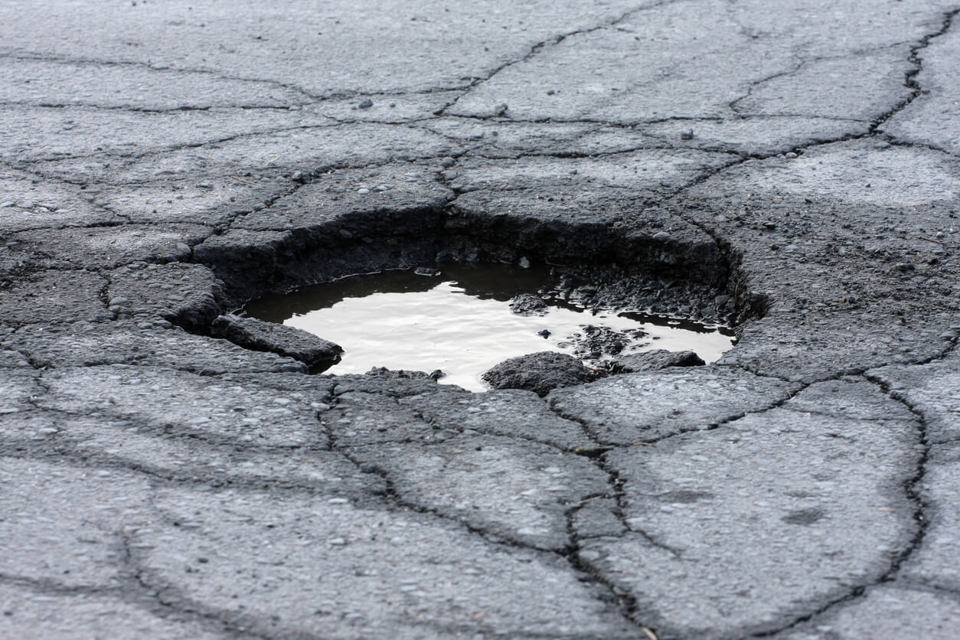The cost of filling the estimated 2.2 million potholes across England and Wales came to £113 million, research suggests.
The Asphalt Industry Alliance (AIA) also reveals that £32 million was paid out in compensation claims and the cost of staff time spent on claims amounted to over £13 million.
Councils have paid out 50 per cent more last year than the previous year in compensation claims from road users for damage or injury due to poor road condition.
The annual national survey of local road network condition and funding published today reveals a crumbling road crisis of increasing concern, renewing calls for Government support for increased and longer term funding.
The 18th Annual Local Authority Road Maintenance (ALARM) Survey was completed by 75% of councils across England and Wales and reports that the number of potholes filled over the last year rose to over two million, an increase of 29% on the previous year.
It comes in the wake of data from Halfords Autocentres which suggests fleet operators have paid out more than £215 million on vehicle repairs over the past year to rectify damage caused by potholes and poorly maintained road surfaces.
Halfords said almost 1.5 million vehicles a year suffer steering and suspension damage as a result of potholes.
The Asphalt Industry Alliance (AIA) is calling for action from central Government to introduce longer-term funding mechanisms, allowing councils to move from one-year costly cycles of highly reactive work to planned, preventative maintenance programmes.
Responding to the Asphalt Industry Alliance’s (AIA) report on potholes, David Brennan, managing director, LeasePlan said: “Potholes are a blight on Britain’s roads and LeasePlan is now calling on the Government to urgently address this growing problem in next week’s budget.
"The £215m allocated to repair these essential arteries in the Autumn has proved inadequate, and it is likely that the recent cold snap will exacerbate the state of the roads further.
“The free and effective movement of people and goods around the UK should be central to the Government’s aim of economic recovery. While billions are being spent on infrastructure projects like HS2 and Crossrail, the progress of these initiatives should not cost the integrity of existing transport networks.”
While the cost of filling potholes is not increasing significantly overall, they indicate poor road condition that is costing the country heavily in many other ways.
This year, local authorities in England (including London) report a shortfall in their annual budgets of £829 million. Across England and Wales, authorities estimate that £10.5 billion would be needed to bring their roads back into reasonable condition.
“Constantly having to patch up crumbling roads rather than using highway engineers’ skills properly, to ensure good road condition in a planned and cost effective way, is nonsensical and costly to the country,” said AIA chairman Alan Mackenzie.
“The DfT’s Potholes Review was a welcome initiative and concluded that ‘prevention is better than cure’. When you add up all the costs incurred by not following this advice, it’s hard to understand why central Government cannot find a way to invest in this much needed work and save on higher costs in the future.”
The local road network accounts for 95% of the country’s roads. One in five local roads is reported as being in “poor condition”, which is defined as having five years or less life remaining.
The longer remedial work is delayed the more its cost increases. Poor local road condition is costing the country’s small and medium-sized businesses a cumulative £52 billion a year in various ways such as reduced productivity, increased fuel consumption, damage to vehicles, and delayed deliveries.
The 59% of ALARM respondents whose roads were damaged as a result of the extreme rainfall in 2012, estimated the total cost of their repairs at £338 million.
Extreme weather has a disproportionate effect on roads that are not kept in good condition and water is particularly damaging to the lower, structural layers of the road.
“Emergency funding from Government is welcome, but a little extra here and there makes very little difference,” said Mackenzie.
“The additional £215 million announced in the autumn to help improve local road condition over the next couple of years doesn’t even cover the £338 million of damage repair needed as a result of last year’s rainfall.
“It’s time to stop the rot. The Government needs to make sufficient funding available now that will enable local authorities to get their roads back into a condition that will quickly and directly boost the economy, help businesses and improve local communities.”
To download the ALARM Survey click here.














Login to comment
Comments
No comments have been made yet.